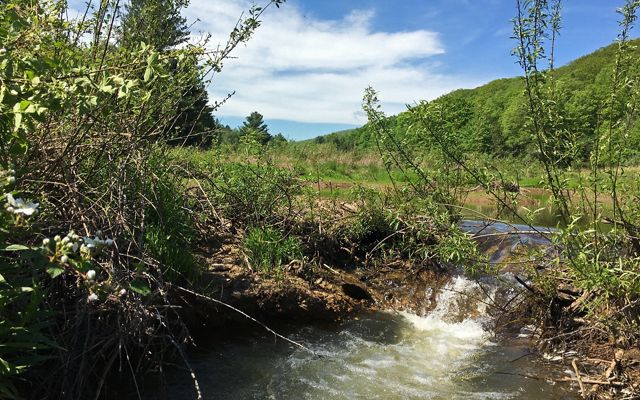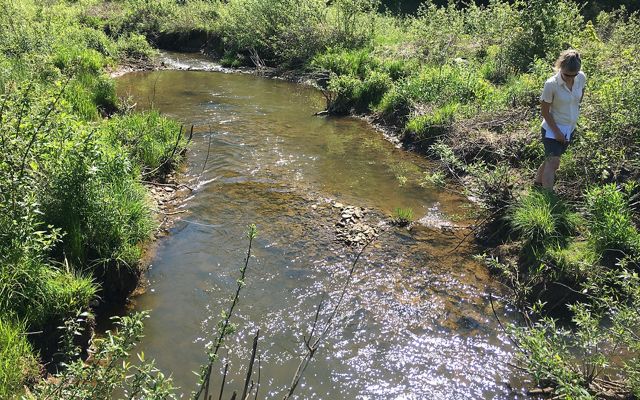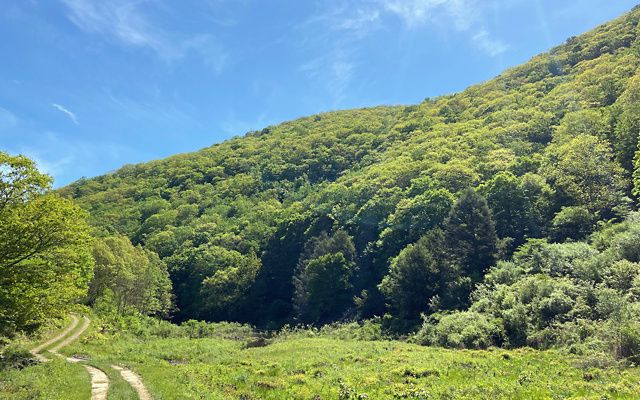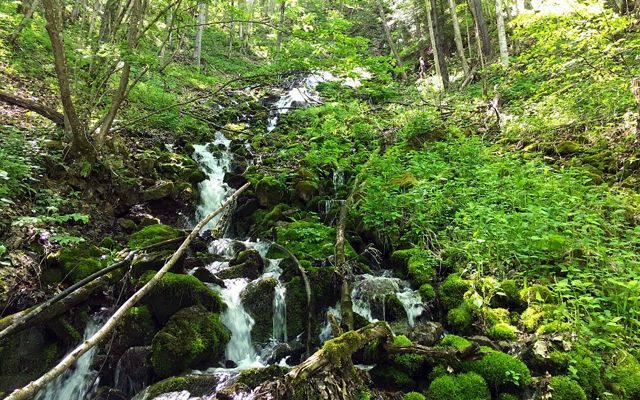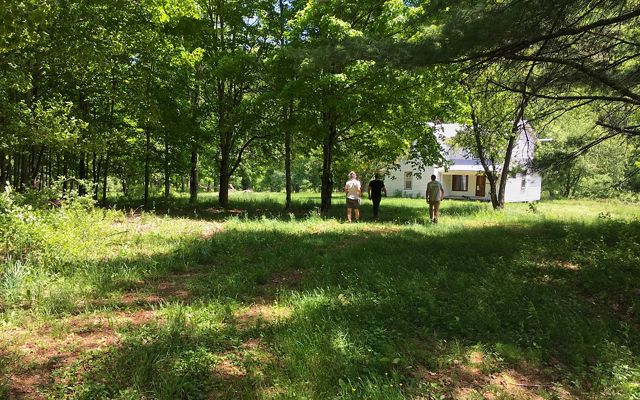Making Connections in the Allegheny Highlands
A partnership protecting nearly 2,000 acres of land will connect diverse habitat thanks to the vision and generosity of landowner Fitz Gary.
On a clear, sunny June morning, excitement is palpable outside the compact post office in Blue Grass, Virginia. I’m eager to explore and document the more than 1,800 recently protected acres in a remote corner of Highland County.
Blair Smyth, director of The Nature Conservancy’s Allegheny Highlands program, is leading today’s excursion. Also along for the day are Holly Korab and John Blackburn from the philanthropy team. After a quick catch-up session in the parking lot, Smyth dangles a teaser. “There’s a stream flowing out of a cave up there that I’m hoping we can find,” he says. The hook is set, and we’re ready to roll out.
Smyth leads our caravan out of the village and up to our first sweeping view of the Blue Grass Valley: green meadows and black cows in the foreground, pale-blue mountain ridges on the horizon.
From Straight Fork to Straight Uphill: Our Quest to Find a Cave
Soon we veer off the main rural road and onto a rough track hugging a forested mountainside on our right. Beyond our driver-side windows, a fringe of trees lines the top of a steep slope dropping down to a stream valley.
We stop several times to clamber downhill and explore Straight Fork, which is anything but straight. For two miles, this braided stream meanders through the property’s valley meadows and connects countless beaver ponds. Our lunch spot features a view of a beaver lodge, and Blackburn spots one of the flat-tailed residents swimming across the pond.
Following directions gathered from conversations with locals, Smyth pulls off shortly before reaching the property boundary. Just ahead to our right, a side stream tumbles down from the mountainside on its way to Straight Fork. Scanning the surrounding landmarks, Smyth tells us he’s reasonably certain that here’s where our bushwhack to the cave begins.
We ascend from the valley floor onto a thickly vegetated bench. Working our way around shrubs and through clinging vines, we make quick progress toward the sound of swiftly flowing water. The approach to the stream takes us into open forest and onto a steep, muddy slope. We forge uphill roughly the length of two football fields, and suddenly there it is.
The stream gushes from a dark rift in the rocky mountain. We take turns rock-scrambling up into the entrance to explore the chasm. Without lights in this shadowy forest, we can barely see beyond 10 feet. Nevertheless, it’s a compelling sight to behold, and the satisfaction of completing our cave quest puts a proverbial cherry on top of our day.
Smyth aptly sums up the remarkable ecological variety we’ve been able to observe in a matter of hours. “The most impressive thing about this project is just the sheer diversity of the habitat we’re conserving up here,” he says. “I mean, you’ve got everything from this cave system to trout streams to beaver meadows to spruce-fir forest to a grove of massive old sugar maples.”
Moreover, the property’s strategic location stands to make an even bigger conservation impact, preserving vital habitat corridors that connect Virginia’s George Washington and Jefferson National Forests with West Virginia’s Monongahela National Forest.
Quote: Blair Smyth

The most impressive thing about this project is just the sheer diversity of the habitat we’re conserving up here.
Land and Love: Protecting a Yosemite in Virginia
That larger conservation impact isn’t lost on landowner Fitz Gary, whose vision and generosity made the project possible. In December 2019, Mr. Gary finalized a permanent conservation easement with TNC covering the entire 1,839-acre property.
While that phase was completed, the partnership was just hitting its stride. Months of discussion about the future of the property ensued, and Gary moved back to Virginia from northern California to be closer to the project. In fall 2020, he donated 1,824 acres outright to TNC for preservation. (He retains 15 acres surrounding his former homesite to use during his lifetime.)
Quote: Fitz Gary

Ches planted the idea—that was years ago. [Now that] I’m getting older, it’s time to make this thing happen.
The project easily ranks as one of the most significant private land donations that TNC has ever received in Virginia. But Fitz Gary, the man responsible for this remarkable gift, claims to be unremarkable.
When Gary used proceeds from his late father’s life insurance to buy the property in 1972, he was “just a young hippie,” he tells me several weeks after I visited his property. It “just happened,” he says, like everything else in his life. But clearly there’s more to his story.
Very little suggests “hippie” in the present-day appearance of this distinguished-looking gentleman with graying hair and thin-rimmed glasses. Rather, with his long mustache and Western-style shirt, Gary bears more than a slight resemblance to actor Sam Elliot.
Gary’s stories, though, do conjure images of the younger man who first ventured into the Blue Grass valley in the early 70s. His first impression of the landscape, he says, was “almost as overwhelming as driving into Yosemite—that same quiet awe—and it’s so lovely.”
But it wasn’t just the land that brought Gary there. It started with the influence of his first love and life-long friend whose family owned property nearby. Years later, Highland County captured Gary’s heart during a road trip with friends from the University of Virginia.
After acquiring his homestead, he moved into a rustic farmhouse nestled in a grove of majestic old sugar maples. Along with the friends who periodically shared his remote getaway, Gary lived without electricity and scooped drinking water from Straight Fork. That was back before the beavers moved in.
“We were young hippies learning to live back in the sticks,” Gary says. Along with the land, they explored the boundaries of consciousness and societal conventions. “We were trying to lose all this conditioning we had acquired,” Gary explains. “It was just the beginning, but it was good, and it was a beautiful place to do it.”
From Vision to Reality: Partnering to Achieve Shared Conservation Goals
A theme that emerges from talking with both Blair Smyth and Fitz Gary is the importance of relationships. They first met shortly after Smyth started at TNC back in 2018. “I remember showing up to this old house in the middle of nowhere, and inside there’s this group of folks who are super excited about conservation,” Smyth recalls.
The group at that initial on-site meeting included Taylor Cole of Conservation Partners and Ches Goodall, who owns neighboring property he’d protected years ago under a conservation easement with TNC. Along with Cole’s advice, Gary cites years of conversations with long-time friend Goodall in his decisions not only to protect his property, but to reach out specifically to TNC.
“Ches planted the idea—that was years ago,” Gary says. “[Now that] I’m getting older, it’s time to make this thing happen,” he adds. For Smyth and TNC, “this thing” extends well beyond Gary’s property. The tract, large and special as it is, is one key patch in a vast quilt of conserved lands. The property lines touch two other TNC preserves, Laurel Fork and Sapling Ridge, as well as the aforementioned easement and two national forests.
Quote: Blair Smyth

Landowners’ wishes for their property matter, and this project is a great example of how we can work together to fulfill their goals while also protecting all the conservation values.
“For Fitz, I think this project is about protecting that piece of property that was his solace and his place to get away,” Smyth says. “But he also realizes how incredibly special that place is ecologically, and he really gets the bigger picture of how it fits into that landscape.”
It’s clear that Smyth has been paying close attention to the landowner’s goals when I get the opportunity to ask Gary directly about his vision and hopes for the land. “Well, the trees are going to grow; the wildlife is going to flourish and stay healthy,” Gary says. Then he moves immediately to “the possibility,” as he puts it, that “filling in” more pieces of the protected corridor would give those animals the habitat they will need to range freely into the future. “If it happens, that would be cool,” he says.
Smyth agrees, and he looks forward to continued conversations with Gary to learn more about the property. And while Gary and the land certainly have unique attributes, Smyth says that the project exemplifies how he and TNC colleagues strive to work with all landowners.
“Landowners’ wishes for their property matter, and this project is a great example of how we can work together to fulfill their goals while also protecting all the conservation values,” Smyth says. “It speaks to how nimble we can be in figuring out the right way to protect an important piece of property.”

Stay in Touch
Sign up to receive monthly conservation news and updates from Virginia. Get a preview of Virginia's Nature News email



